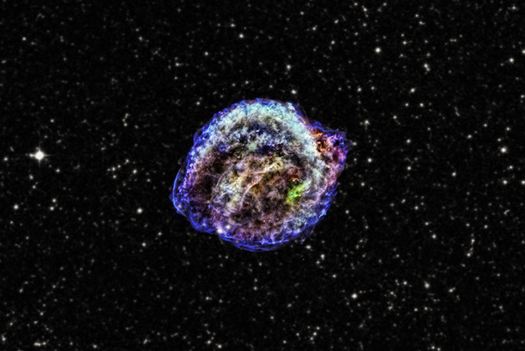Chandra’s 14th Anniversary: Looking Back and Looking Ahead
Fourteen years ago this week, NASA's Chandra X-ray Observatory was launched into space on the space shuttle Columbia. I didn't witness this spectacular event, but I know many who did. Those who had worked on Chandra's development for many years must have experienced a powerful mixture of nerves, excitement and satisfaction.
The launch and deployment of Chandra were successful and beautiful images were soon delivered to scientists and released to the public. The photo album on our webpage can be used to survey the hundreds of images and astrophysics results that have followed, ranging from observations of Earth and planets in our solar system, to supernova explosions in our galaxy, powerful outbursts by black holes in distant galaxies and the evolution and destiny of our Universe.
Just in 2013 we have released a video suggesting that the Vela pulsar is wobbling like a top as it spins; an image of debris from an explosion that may have created the youngest black hole in our galaxy; colorful new images of other stellar debris in our galaxy, including Kepler's supernova remnant (SNR), and the SNRs of SN 1006 and G1.9+0.3; and a study that discovered over two dozen new black hole candidates in a neighboring galaxy, Andromeda. All of these objects formed after the destruction of massive stars or white dwarfs in supernova explosions.

Chandra image of Kepler's supernova remnant. Credit: X-ray: NASA/CXC/NCSU/M.Burkey et al; Optical: DSS
For stars that are more like our Sun, we released this gorgeous composite image with the first evidence for X-ray emission from Sun-like stars outside our galaxy and we also produced this eye-catching portrait of a star near the end of its life.
What does the future hold for Chandra science? In the middle of June scientists from around the world met to judge proposals and determine the targets for the next cycle (#15) of Chandra observations. The abstracts for the successful proposals will be released soon. Looking further ahead, future targets for Chandra will depend on the results from past observations and those to be made in Cycle 15, along with results from other observatories. It will also depend on the unpredictable trends in research over a range of different fields in astrophysics.
Among this uncertainty, I'll discuss one event that could be very interesting for Chandra observers towards the end of this decade. A star named S2 is orbiting Sagittarius A* (Sgr A*, for short), the supermassive black hole at the center of our galaxy. As with other supermassive black holes, the powerful gravitational pull of Sgr A* has pulled gas inwards and formed an accretion disk. Some of the gas in this disk is destined to fall into the black hole and disappear forever.
As noted in a recent paper by Dimitrios Giannios from Purdue University and Lorenzo Sironi from Harvard-Smithsonian Center for Astrophysics, S2 approaches so close to Sgr A* that it may act as a probe of the black hole's accretion disk. Astronomers have mapped the highly elliptical orbit of S2 (see the figure) and expect it to pass through the accretion disk every 16 years. At closest approach S2's distance from Sgr A* will be about 2800 times the radius of the event horizon of the black hole, the point of no return for matter and light. That may not sound very close, but it's much closer than I'd ever want to get to a black hole.

Left: An image of Sgr A* and S2 from the 8.2m VLT YEPUN telescope at the ESO Paranal Observatory. Right: The orbit of S2 around Sgr A*, highlighting the last close encounter, in 2002. Credit: ESO
The next close encounter of S2 with Sgr A* will occur in 2018 when the star is traveling about 20 million miles per hour. What might happen in this encounter? Giannios & Sironi have noted that S2 is a massive star and generates a powerful wind of particles. When S2 passes through the accretion disk, this wind should ram into material in the disk producing a shock wave and X-ray emission, not dissimilar to a sonic boom from a jet breaking the sound barrier. Chandra and X-ray observatories like NuSTAR might be able to detect a boost in X-ray emission during this time, giving us crucial information about the properties of Sgr A's accretion disk. The authors are also looking at Chandra data in the archive for the close encounter that occurred in 2002, to see if extra X-ray emission can be detected.
This is just one example of the exciting Chandra science that is possible in the future. Though it's fun to look ahead, it's important to pause and thank everyone who helped Chandra become a reality and those who continue to work on Chandra today.
-Peter Edmonds, CXC
Please note this is a moderated blog. No pornography, spam, profanity or discriminatory remarks are allowed. No personal attacks are allowed. Users should stay on topic to keep it relevant for the readers.
Read the privacy statement
